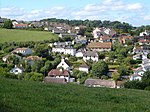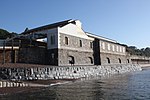South Devon Railway sea wall
Buildings and structures in DevonCommons category link is locally definedDawlishEngvarB from August 2014Industrial archaeological sites in Devon ... and 4 more
Natural disasters in EnglandRail transport in DevonSeawallsWorks of Isambard Kingdom Brunel

The South Devon Railway sea wall is situated on the south coast of Devon in England. A footpath runs alongside the railway between Dawlish Warren and Dawlish, then another footpath forms a continuation to the sea front promenade at Teignmouth. Both of these form part of the South West Coast Path. The South Devon Railway was built to the designs of Isambard Kingdom Brunel; it takes a route from Exeter which follows the River Exe to Dawlish Warren, runs beneath the sea cliffs to Teignmouth and then follows the River Teign to Newton Abbot. It follows tidal waters for about 13 miles, 4 of which are open sea.
Excerpt from the Wikipedia article South Devon Railway sea wall (License: CC BY-SA 3.0, Authors, Images).South Devon Railway sea wall
Old Teignmouth Road, Teignbridge
Geographical coordinates (GPS) Address Nearby Places Show on map
Geographical coordinates (GPS)
| Latitude | Longitude |
|---|---|
| N 50.569 ° | E -3.4694 ° |
Address
Old Teignmouth Road
EX7 0RT Teignbridge
England, United Kingdom
Open on Google Maps










